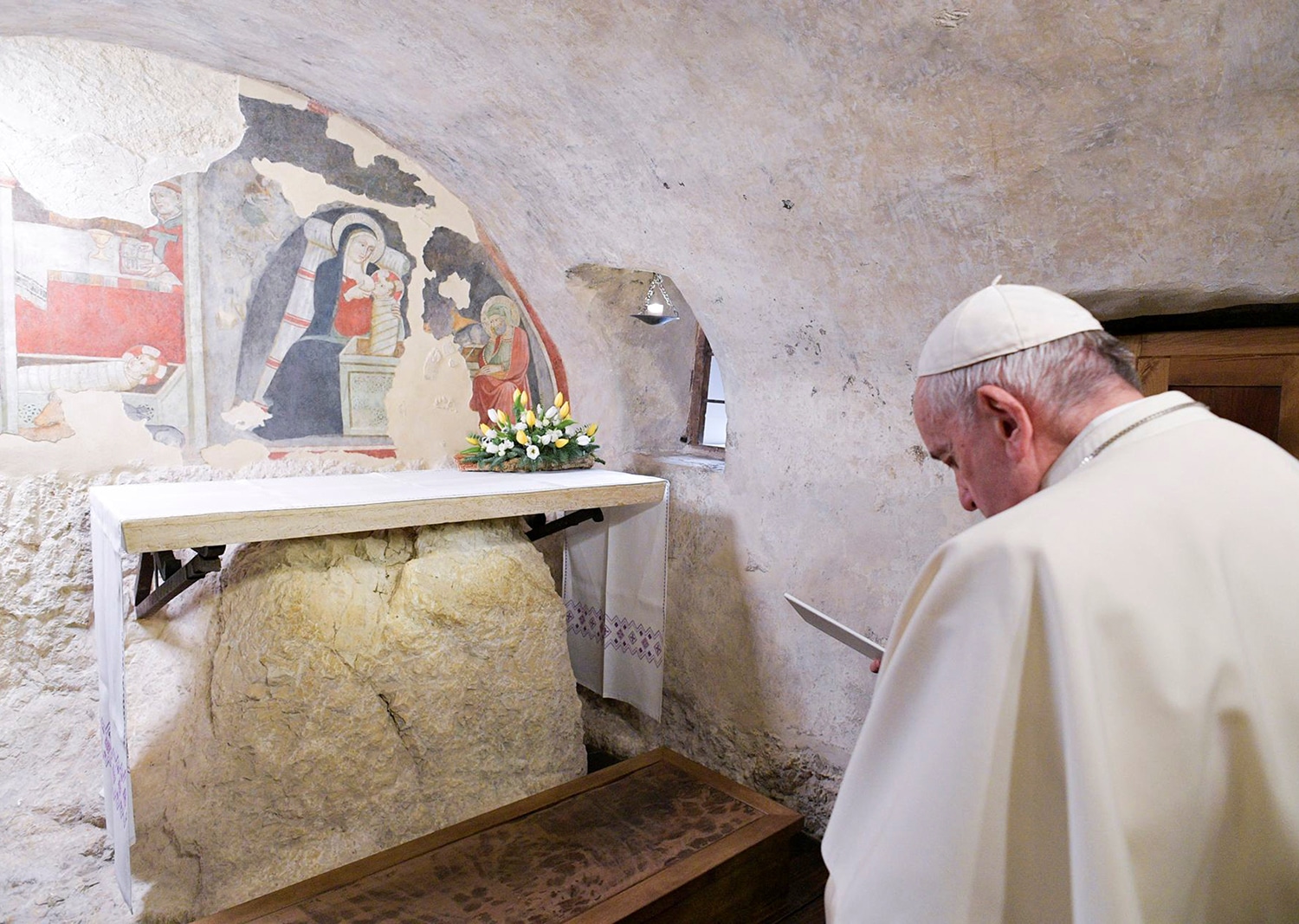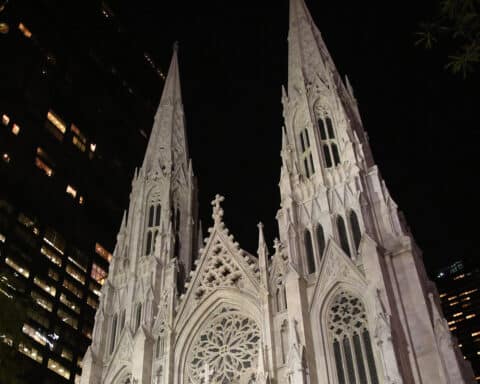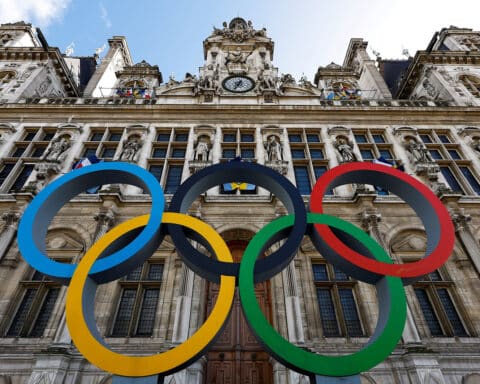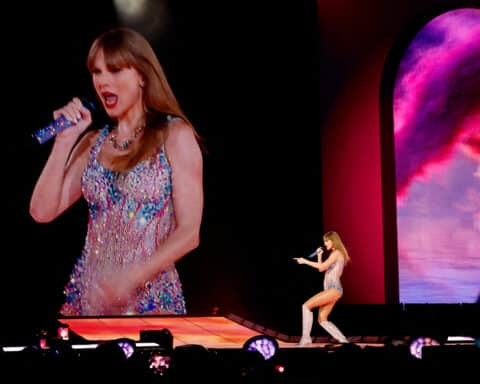ROME (OSV News) — Every year, the Vatican unveils a Nativity scene from a different diocese, often using materials or artistic styles from the particular region or country where the diocese is located.
Some Nativity scenes have garnered praise for their depictions of Christ’s birth, such as the “Sand Nativity” in 2018, a massive 52-foot wide bas-relief sculpture made with over 700 tons of sand imported from Jesolo, an Italian seaside resort town roughly 40 miles north of Venice.
Others, like the 2020 Nativity scene, which featured not-so-traditional sculptures of Mary, Joseph and baby Jesus — as well as a knight that some compared to Darth Vader and what seemed to be an astronaut — drew more divided reactions from the faithful and the world.
As different as they seem, they have a very traditional background — and a famous saint that started them in 1223 — St. Francis of Assisi.
The first Christmas crèche
The first crèche was created centuries ago in the central Italian village of Greccio. In 2023 the crèche celebrates its 800th birthday.
Italian Franciscan Father Simone Castaldi, secretary of the Franciscan Province of St. Bonaventure in Rome, said the commemoration of both anniversaries “are a wonderful opportunity to place the witness of Francis of Assisi back at the center of Christian spirituality.”
“Francis is a simple figure with an incredible story of deep and embodied spirituality,” Father Castaldi told OSV News Nov. 14. “Everyone talks about St. Francis but few people
know the profound experience, which moves mainly from his love for the Incarnation.”
The story of the first Nativity
The story of how the first Nativity scene came to be can be found in the hagiography written in 1229 by Franciscan Brother Tommas of Celano, who was commissioned by Pope Gregory IX to write about St. Francis’ life.
For St. Francis, Brother Tommaso recounted, “the humility of the Incarnation and the charity of the Passion so occupied his memory that he would scarce ponder over anything else.”
According to the Franciscan brother’s account, St. Francis, before making his way to Greccio to celebrate Christmas, sent word to Giovanni Velita, a friend and mayor of the town, and instructed him to prepare a recreation of the Nativity.
“Make haste to go before and diligently prepare what I tell thee,” St. Francis said, according to Brother Tommaso. “For I would make a memorial of that Child who was born in Bethlehem, and in some sort behold with bodily eyes his infant hardships; how he lay in a manger on the hay, with the ox and the ass standing by.”
Humility and poverty
For Polish Franciscan Father Emil Kumka, an expert on early and medieval church history, as well as Franciscan history and hagiography, at Rome’s Pontifical Theology Faculty of St. Bonaventure, also known as the Seraphicum, the aforementioned passages in Brother Tommaso’s account are the key to understanding St. Francis’ inspiration for creating the Nativity scene.
“The humility of God, who wanted not only to become man by natural birth, but first and foremost his choice of poverty and lowering to our human level, provoked in St. Francis the desire to relive this moment,” Father Kumka told OSV News Nov. 11.
“The conditions in Greccio had to be the same as in Bethlehem, namely extreme poverty, which fully demonstrates the divine ‘kenosis,'” he added, referring to St. Paul’s words in which explains that Christ “emptied himself” in taking on human form.
Father Castaldi told OSV News that while St. Francis is “a saint that everyone knows,” it often happens that “almost no one really understands him,” especially when it comes to understanding his motivations for creating the Nativity scene.
“It is true that on that Christmas night 1223, Francis depicted a scene of the Nativity for the first time in history,” he said. “But we cannot fail to consider that what Francis does is something much more profound than just making the first crèche.”
Devotion to the ‘Child of Bethlehem’
To explain this, Father Castaldi noted a specific passage from Brother Tommaso’s account that described what St. Francis would do when he pronounced the words, “Child of Bethlehem.”
In his hagiography, Brother Tommaso said that when naming Christ, St. Francis, “aglow with exceeding love, would call him the ‘Child of Bethlehem,’ and uttering the word ‘Bethlehem,’ in the manner of a sheep bleating, he filled his mouth with the sound, but even more his whole self with the sweet affection.”
“Moreover,” the account continues, “in naming ‘the Child of Bethlehem’ or ‘Jesus,’ he would, as it were, lick his lips, relishing with a happy palate, and swallowing the sweetness of that word.”
Father Castaldi said the description was “one of the most beautiful passages from the night of Greccio; one of the most human passages and one that I believe best describes Francis.”
St. Francis’ devotion to the Incarnation and his love for Christ, he explained, was “a passion that became physicality and a bodily sense.”
“Everything must be traced back to Francis’ desire to see, and thus live, the poverty chosen by Jesus in the incarnation,” Father Castaldi said.
Christmas joy
In his account, Brother Tommaso also described the joy felt by St. Francis, as well as by those in the small Italian village who witnessed that Christmas celebration so long ago.
“There simplicity was honored, poverty exalted, humility commended; and of Greccio there was made as it were a new Bethlehem,” he wrote. “The night was lit up as the day, and was delightsome to men and beasts. The people came, and at the new mystery rejoiced with new rejoicings.”
Father Kumka said that St. Francis’ creation of the Nativity scene was “not spectacle, not religious theater, nor sentimentalism; that is, everything that the Nativity crèche often represents to people today.”
Connection to the Eucharist
Instead, he explained, the Christmas Mass celebrated with a physical representation of the Son of God lying in a humble manger, joined together two important points of devotion in St. Francis’ own spiritual life: the Eucharist and the Incarnation.
Both, Father Kumka told OSV News, “referred back to the same basic choice: that of a God who humbled himself for the salvation of humankind.”
“The Eucharist perpetuates Christ’s presence in history and demands, at the same time, that — like Christ — we know how to dispossess ourselves of everything,” he said. “The Christmas liturgy of Greccio does not remain fixed on what happened in Bethlehem, but follows Jesus all the way to Golgotha and recognizes him as the one who is risen and glorified, and who today again stoops down and gives himself to us in holy Communion.”
Father Castaldi echoed similar sentiments and emphasized that in the simplicity and humility of the manger, St. Francis wanted to “show a way of being in the world: that of the peace that comes from being in the minority, from occupying the last place.”
“This is the revolution that he will bring into history by breaking the feudal pyramidal hierarchy and replacing it with the circle of brotherhood, in which everyone is on the same level,” Father Castaldi told OSV News.
“In the night of Bethlehem, Francis saw how God made the first move: He chose to occupy the last place.”





